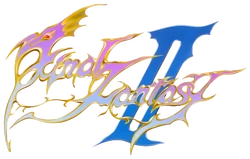Template:Sideicon
| Template:Infobox CVG |
- For the game originally released as Final Fantasy II in North America, see: Final Fantasy IV.
Final Fantasy II is the second installment in the Final Fantasy series. It is notable for being one of the first story-intensive RPGs released for a console system, and for being the first game in the series to feature many elements that would later become staples of the Final Fantasy franchise, including chocobos and a character by the name of Cid. Final Fantasy II is also unique for eliminating the traditional experience-based advancement system, instead favoring a system wherein the playable characters' statistics increase according either to how much they are required, or how much they are used. In other words, a character who frequently casts magic spells would have their proficiency at casting increase faster than a character who specializes in physical attacks. This is called the skill-based advancement system, which would later return in Final Fantasy XI.
Although abandoned by subsequent installments in the series, a similar system was adopted by the SaGa series, also produced by Square. As a side-note, Final Fantasy II was actually designed by Akitoshi Kawazu, who later designed the SaGa series, rather than Hironobu Sakaguchi, the series' creator. Because of the series' popularity in America during the '90s, Final Fantasy II was one of the first games to undergo fan translation, in this case by NeoDemiforce. Final Fantasy II was originally scored by Nobuo Uematsu, and it was Uematsu's seventeenth work of video game music. The game's music was arranged by Tsuyoshi Sekito for the WonderSwan Color, PlayStation, Game Boy Advance and PlayStation Portable remakes.
Gameplay
Final Fantasy II is unique in the Final Fantasy series for not utilizing experience-based levels. Instead of earning experience points at the end of every battle, each character participating in battle develops depending on what actions the character takes during the battle. For example, characters who frequently use a particular type of weapon (sword, Bow, axe, etc.) will become more adept at wielding a weapon of that type, as well as increasing their physical strength. Similarly, characters who frequently cast a particular magic spell will learn to cast more powerful versions of that spell, as well as increasing their magical power. HP and MP, will similarly increase depending on need: a character who ends a battle with only a small amount of health remaining may earn an increase in their maximum amount of hit points, and a character who expends the majority of their magic points during a single battle may increase their maximum amount of magic points.
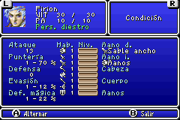
Screen of condition in Final Fantasy II, where it is possible to see the level of training with every weapon.
A handful of bugs related to this advancement system were still present in the game's released version, the most notable of which was the ability to cancel a previously issued command and still gain the stat-increasing benefits of having performed the action. This was possible because the game's turn-based battle system gave the player the opportunity to input commands for all four members of the battle party at once. At any point in time before the command for the final character in the lineup was issued, the player could hit a button and return to the previous character to reissue a command.
Since many statistics, such as weapon and magic spell proficiency, were based on how many times a particular command was used in battle, a little patience meant it was possible to quickly advance in proficiencies in the space of a single battle round. A similar problem manifested in the way hit point increases were granted, which allowed characters to attack members of their own party to increase their maximum hit points. These problems were faithfully replicated in both the WonderSwan Color and the PlayStation ports. The Game Boy Advance remake eliminated the command cancel bug, though the hit point increase trick remained. Various other changes were made to the Game Boy Advance Version, including regular maximum hit point increases outside of those gained as outlined above, to decrease game difficulty.
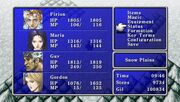
Menu screen of Final Fantasy II.
Battle parties can consist of up to four characters at a time. Three of these characters are present throughout the entire game, but the fourth position rotates amongst a variety of characters. Final Fantasy II was the first game in the series to allow a friendly character to be placed in the "back row" during battles. Characters placed in the back row are immune to most physical attacks, but can be harmed with bows and magical attacks. In a similar way, enemies can be arranged in up to four rows of two creatures each (for a maximum of eight hostile opponents on screen at any one time). Only the two rows closest to the player's party could be damaged with physical attacks. By eliminating the two closest rows the player can then physically damage the other rows of enemies.
Throughout the course of the game, when in conversation with Non-Player Characters (NPCs), the player has the ability to "learn" special words or phrases, which can later be repeated to other NPCs to gain more information or unlock new actions. Similarly, there exist a handful of special items that can be shown to NPCs during conversation, which have the same effect.
Characters

The main cast of Final Fantasy II.
Final Fantasy II was the first game in the series to have an actual main cast of characters with names and histories. The first three characters can never be changed, whilst the fourth character is always changing.
- Firion is the main character. The adopted friend of Maria and Leon, and childhood friend of Guy, he seeks to destroy the empire in hopes of avenging his fallen family.
- Maria is Firion and Guy's childhood friend, and the female lead. She quests in the hopes of finding her brother Leon, who disappeared after being attacked by the Empire.
- Guy is a friend of Firion and Maria. He speaks in a stunted manner, and has the ability to speak to animals. However, this is a unique ability and it is only used once in the entire game.
- Leon is Maria's older brother, and the new Dark Knight of Palamecia. He went missing during the attack on Fynn, and has since grown to be the emperor's most faithful follower. Late in the game, he joins the trio and helps them defeat the final boss.
- Minwu is a White Mage and Hilda's personal adviser. He joins the party during their first adventures, and is learned in the arts of magic.
- Josef is a miner, and helps the resistance gain mythril. He joins the party for only a short time, but his small contribution matters greatly in the end.
- Gordon is the prince of Kashuan, and fled from battle after his brother, Scott, died in the battle for Fynn. He believes himself to be a coward, and to prove himself fit for the throne, he journeys with Firion and his allies to aid in the defeat of the empire.
- Leila is a pirate who attempts to rob the party, but her crew is weak and Firion, Maria, and Guy easily defeat them. She repents, and decides only to attack the Empire instead.
- Ricard Highwind is the last Dragoon of Deist. Having been stuck in Leviathan for some time, he is quite eager to return to action and stop the Empire in order to avenge his fallen allies.
- Scott is a prince of Kashuan and the older brother of Gordon.
Story
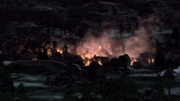
Fynn burns.
The story begins when Emperor Mateus of Palamecia summons forth monsters from Hell in his quest to dominate the world. Firion, Maria, Guy, and Leon are orphaned when the Empire attacks Fynn and they are cut down by imperial soldiers as they flee. Firion, Maria, and Guy are rescued by forces belonging to the Wild Rose Rebellion led by Princess Hilda and taken to Altair to be revived, but Leon has gone missing. Though they ask to join the rebellion, Hilda refuses due to their youth and inexperience.
Despite this, Firion, Guy, and Maria return to Fynn and find Prince Scott on his deathbed. He tells the party of Count Borghen's betrayal and asks them to encourage his brother Gordon, who is afraid to join the rebels. Scott asks them not to tell Hilda his feelings for her and gives them a ring to take back just before he dies. Returning Scott's ring convinces Hilda that Firion's group is strong enough to join the fight.
She sends the group to Salamand in search of Mythril. Josef, a member of the rebellion was sent to search for it, but Hilda hasn't heard anything from him since. Hilda's right-hand man, Minwu, also joins the party for this mission. The party finds Josef, but he is unwilling to give any information, as the Palamecian empire have kidnapped his daughter Nelly, and Borghen has threatened to kill her if Josef helps the resistance. He tells them to go to the Semitt Falls and free her, along with the townspeople who have been enslaved in the mines. They do so and also rescue Paul, a thief in the rebellion's employ. After defeating one of the imperial Sergeants, the party take the Mythril and make their way back to Altair.
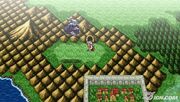
The Dreadnought rises.
After the weaponsmith Tobul crafts Mythril Equipment for the resistance, the party is dispatched to Bafsk. The Palamecian Empire have enslaved the residents and made them build a powerful airship known as the Dreadnought. It was built under the watchful eye of an imperial known as the Dark Knight, but he was replaced by Borghen after the loss of the Mythril. This gives the resistance the perfect opportunity to destroy the Dreadnought before it is finished. However, just before the party reaches the massive airship from the Bafsk Sewers, the Dark Knight, who actually has not left Bafsk after all, takes control of the airship and lifts off. The Dreadnought attacks the cities of Poft, Paloom, Gatrea and Altair, but miraculously the secret base at Altair is unharmed. Minwu leaves the party to care for the ailing King. After talking to Cid, owner of the world's other airship, Hilda and the party decide to obtain Sunfire from Kashuan Keep. To enter, they need either the Goddess's Bell or the voice of a Kashuan. Josef helps the party reach the Snow Cave with a snowcraft, and the party retrieves the bell located within. On the way out, Borghen attacks the party, and although he is defeated, he sends a boulder after them. Josef holds back the boulder to allow the party to escape and is crushed.
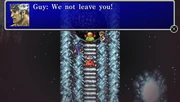
Josef's death.
With heavy hearts but renewed determination to avenge Josef, the party heads for the abandoned kingdom of Kashuan to retrieve the Sunfire. They enter the keep and find Gordon, who came on his own but was unable to make it past the monsters inside. He joins the party and helps them to locate Egil's Torch, the only vessel they can use to carry the Sunfire. The party defeats a Red Soul for the torch and retrieve the Sunfire. As they leave, they witness Cid's airship being captured by the Dreadnought, which then parks to replenish fuel supplies in the far south. The party heads there, frees Cid (and Hilda, who was on board Cid's airship), and throws the Sunfire into the Dreadnought's engine as directed by Cid. They meet the Dark Knight in the engine room and Maria recognizes his voice, but they have no time and escape just before the airship is destroyed.
The party returns triumphantly to Altair, only to learn the King is about to die. With his last breaths, he plans a three-pronged attack on the empire in an attempt to take back Fynn. In his plan, Minwu heads to Mysidia to retrieve Ultima, the ultimate magic tome, Gordon takes command of the rebel army to attack Fynn directly, and Firion's party heads to the island nation of Deist to enlist the aid of the Dragoons. Hilda has started behaving strangely and retires to her chambers. The party accepts passage from Leila, who reveals that she is a pirate captain and tries to mug the party. When they defeat her and her crew, she is impressed and joins them. They reach Deist, but find that the Dragoons have fallen in battle and only a single Wyvern remains alive. The beast is dying, poisoned by the Empire. It gives the party the last Wyvern Egg, which the party drops in the healing spring at the bottom of Deist Cavern in order to incubate it and hasten its growth process.
The party returns to Altair empty-handed and Firion learns that the Hilda they rescued is a Lamia Queen in disguise. They soon learn the real Hilda is being held as a prize in the tournament at the Palamecian Coliseum. The party, with Gordon in tow, make haste to reach Hilda, defeating a Behemoth at the Coliseum to earn Hilda as a prize. However, The Emperor, who is overseeing the match personally, dispatches the party and has them thrown in the dungeons. They are saved by Paul, who unlocks their cell. Hilda and Gordon escape on their own while the rest of the party draws the guards' attention.
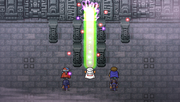
Minwu breaks the Ultima Seal.
The rebel army plans an attack on Fynn and encamps outside the town. Firion, Maria, Guy and Leila lead the attack and defeat the imperial castellan, Gottos, earning the rebels an important victory. However, Minwu and the Ultima Tome are nowhere to be found so Hilda instructs the party to look for Minwu and retrieve the Tome from the Mysidian Tower. After obtaining the Crystal Rod from the trials on the Tropical Island, the party heads for the Tower, only to be swallowed by the Leviathan. Shipwrecked and separated from Leila, the party works its way from Leviathan's innards to the mouth, where, with the help of Ricard Highwind the Dragoon, they are able to retake the ship by defeating a Roundworm. They head for the Tower with Ricard, best the Fire Gigas, Ice Gigas and the Thunder Gigas and find Minwu at the Chamber of the Seal. He has been waiting for Firion's group to arrive; once they are there, he uses his life force to break the seal.
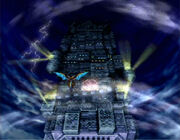
Within the Cyclone.
The party takes Ultima and returns to Fynn, but they discover that the towns of Altair, Gatrea, Paloom and Poft have been utterly destroyed by a mysterious force known as the Cyclone. It threatens to tear the world asunder if the party cannot figure out how to stop it. Hilda tells them that a pendant can be used to call wyverns in the chamber at the top of the castle, and Paul gives them the item. The pendant calls the young wyvern that was hatched at Deist, and they fly it into the Cyclone.
They infiltrate the fortress inside the storm and manage to defeat the Emperor. A victory celebration is held at Fynn, but it is soon interrupted by the news that the Dark Knight is Maria's long-lost brother Leon, and he has crowned himself Emperor. Cid, dying after the attack on Paloom, gives the party his Airship, and they fly to Palamecia. Leon refuses Maria's pleas and prepares to battle, but the Emperor returns from Hell, now more powerful than ever, and reclaims his throne. Ricard sacrifices himself in battle against the Emperor so that the others can escape on the Wyvern.
After Ricard's death, the Dark Emperor raises Castle Pandaemonium, the fortress of the Lord of Hell, to start a new empire. Leon agrees to join the party at Firion's behest and they set out to prepare for the final battle. After returning to Deist to earn the Excalibur, the treasured sword of the Dragoons, the party fights its way through the Jade Passage, entering Pandaemonium from underneath as all other forms of approach are impossible. Inside the castle, the party fights its way through several of The Emperor's most powerful minions, including an undead Borghen, en route to The Emperor's throne at the top of the castle.

Mateus in Pandaemonium.
A fierce battle ensues as the Emperor attempts to destroy the last hope of the resistance. Despite his powerful spells and his ability to call down meteors, Firion and the others defeat him for good. They return to Castle Fynn where Hilda, Gordon, Nelly, Leila and Paul all wait to congratulate the party on the victory. In the battle's aftermath life begins anew for everyone. However, Leon takes his leave of them, feeling that too much has happened between them for him to stay. Maria protests, but Firion says that they will be waiting when Leon is ready to return.
With the war's end, the monsters called from Hell vanish without a trace and the world returns to peace, eventually to forget the bitter memories save for the efforts of the young heroes who saved them all.
Soul of Rebirth
In the Game Boy Advance and PlayStation Portable Versions, a new story, titled Soul of Rebirth, tells the tales of the four party members who died defending Firion and his party in an attempt to see The Emperor defeated.
Minwu wakes up to find himself in a mysterious cave and tries to figure out where he is. He soon finds Scott, the prince of Kashuan, who had died earlier on in the game. After defeating a few soldiers, the two find Josef, who is confronted by a hideous zombie-version of Borghen. The three of them defeat Borghen, and start searching for answers about where they are. They find Ricard, who is fighting the Roundworm, and aid him in battle. He then joins Minwu's party. The party finds their way out of the passage, where they learn that they are, in fact, in the afterlife. The town of Machanon was built as a safe house for all the souls trapped in this unknown dimension. Here, they find Cid, Tobul and other rebels, who helped build the place, and who encourage the party to explore the other two mysterious portals that appeared in Machanon not long ago.
After adjusting themselves to the difficult battles of the afterlife, Minwu and the party enter one of the portals, and find themselves in the Chamber of the Seal, Minwu's resting place. Again, Minwu must break the seal; however, this time, he is powerful enough to break the seal without sustaining any fatal injuries. The party enters the chamber and attempts to claim Ultima, but are met with the guardian of the spell in the afterlife: the Ultima Weapon. After a fierce duel, the party is able to defeat the monster, and claim Ultima as their own.
This leaves one final portal, which leads to the Unknown Palace. Like Pandaemonium before it, the Palace is guarded by fierce creatures, and contains some of the most powerful equipment in the game. Specifically, Minwu's party finds four exclusive pieces of equipment: the Stardust Rod (for Minwu), the Wild Rose (for Scott), the Bracers (for Josef), and the Wyvern Lance (for Ricard).
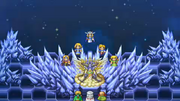
The party meets their loved ones.
After all the battles, the party meets the Light Emperor, who asks for forgiveness for his dark side's actions. The Light Emperor tells them he split into two entities when he was originally defeated, and that Firion and the party defeated the dark half in Pandaemonium. He also explains they are actually in Arubboth, the passage to Heaven, and that they can finally rest in peace. The four are led to believe his words; however, the subconscious souls of their still-living friends and family appear and tell them they must not be fooled by the Light Emperor, because in reality, he is just as evil as the Dark Emperor. The party recover their lost will to fight and defeat the Light Emperor. After his defeat, the four heroes return (at least in spirit) to Castle Fynn, where they witness the events that played out at the end of the regular game. These events are told from their perspective this time, and the player is given an explanation as to why Firion saw the ghosts of the four dead heroes at the regular game's conclusion. The story ends with Minwu, Scott, Josef and Ricard finally fading away, presumably going to Heaven for real this time...
.
Music
Final Fantasy II was originally scored by Nobuo Uematsu, and was his seventeenth work of video game music. The game's music was arranged by Tsuyoshi Sekito for the WonderSwan Color, PlayStation and Game Boy Advance remakes, who also composed the two new boss battle themes for these releases. There were also a batch of music themes made for the Famicom Version that were unreleased for reasons unknown. Some of the music is not original to the game, but is taken from Tchaikovsky's Swan Lake ballet.
Final Fantasy II had three unused themes composed by Nobuo Uematsu: an Airship Theme, removed due to being too "happy" for this rather dark game; a dungeon theme, removed from the game and later used for Final Fantasy VI; and a "shop theme", ultimately removed for being too similar to the shop theme from the original Final Fantasy.
Development

The scripted opening battle in the Famicom version.
Unlike in the first Final Fantasy, the player can't create their own characters in Final Fantasy II and there is no job system. There were two reasons for this: the first being that Final Fantasy II was intended to be a more story-driven game than the first Final Fantasy and would need specific characters to fulfill roles within the story. The second reason was the idea that the system would be more about nurture than nature: the player doesn't choose a character in the beginning, but they can make them grow in a certain way eventually becoming anything the player set them up to be.[1]This way the character-building process would continue throughout the entire game. When making the system the developers didn't anticipate it would lead to a system where players could easily exploit it. The ability to hit party members was included so players could hit sleeping characters to wake them up[1], but instead people used it to grind levels.
Final Fantasy II was originally released for the Nintendo Family Computer in Japan in 1988. There was some initial talk that either Nintendo of America or Square Soft (Square's North American subsidiary) might localize the title for American audiences as had been done with its predecessor in 1990. Such a project was announced and an early prototype cartridge was produced in 1991 as Final Fantasy: Dark Shadow Over Palakia, but the game was ultimately canceled in favor of the more recent Final Fantasy IV. The game was never released outside of Asia in its original form. Enhanced remakes of the game were later issued for the Bandai WonderSwan Color (WSC), the PlayStation (as part of the Final Fantasy Origins collection), the Game Boy Advance (as part of the Final Fantasy I & II: Dawn of Souls collection), and the PlayStation Portable. Final Fantasy II was, for the first time, released in Europe and other regions when it became part of the Origins compilation.
Unreleased English Version
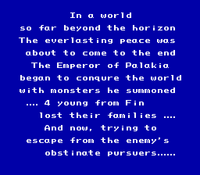
Screenshot from the unreleased English prototype.
Following the successful release of the original Final Fantasy by Nintendo in 1990, Square Soft, Square's North American subsidiary, began work on an English language localization of Final Fantasy II. Assigned to the project was Kaoru Moriyama, whose later work included script translations for Final Fantasy IV and Secret of Mana. Although a beta version was produced, and the game was advertised in several Square Soft trade publications, the age of the original Japanese game and the arrival of the Super Nintendo Entertainment System, the NES's successor console, led Square Soft to cancel work on the Final Fantasy II localization in favor of the recently released Final Fantasy IV (which, to avoid confusing North American gamers, was retitled Final Fantasy II to reflect the jump in releases).
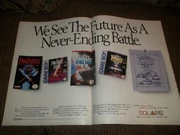
Old promotional poster that includes prototype cover artwork for the NES versions of Final Fantasy II and Final Fantasy III, neither of which were released in the US.
Although a prototype cartridge of the NES Final Fantasy II was produced (with the subtitle Dark Shadow Over Palakia), Moriyama admitted the project was still far from being complete. He is quoted as saying:
"We had so very limited memory capacity we could use for each game, and it was never really "translating" but chopping up the information and cramming them back in... [Additionally] our boss had no understanding in putting in extra work for the English version at that time."[2]
The English script for the prototype version is clunky and erroneous, but it was only the preliminary version and it was cut down in length to fit the text area. The project was cancelled before the script was refined.[2]
Even at the prototype stage changes had been made from the original version due to the religious imagery policies Nintendo had at the time: The Star of David used in a dungeon design was replaced with a triangle and the cross that replaces a character's face on the pause screen at death was replaced with a gravestone.[3]
In 2003, when the game was finally released to English-speaking audiences as part of Final Fantasy Origins, it was released with a brand new translation produced under the supervision of Akira Kashiwagi. NeoDemiforce's fan translation, similarly, made use of an original translation, as the existence of the prototype cartridge was not common knowledge at the time.
Ports and Remakes
Wonderswan Color
The first remake of Final Fantasy II was released on May 3, 2001. The most notable change to the game was the graphical updating, which included more detailed sprites, a total revamping of battlefield and dungeon backgrounds, better sounds and higher resolution overall.
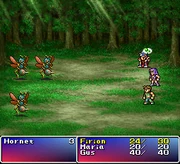
A battle in the Origins version.
PlayStation
North America's (and the rest of the world's) first access to Final Fantasy II was through the Final Fantasy Origins collection, which also included the original Final Fantasy. The graphics and gameplay remained nearly identical to that of the Wonderswan, though resolution increased by a marginal amount. Due to the PlayStation's higher processing power, several new features were added, such as a full motion video scene, much better sounds, a Bestiary, art gallery by Yoshitaka Amano, and an item collection gallery. The game also features Easy and Normal modes of play.
Game Boy Advance
Final Fantasy II was once again paired with Final Fantasy for the Game Boy Advance, under the compilation Final Fantasy I & II: Dawn of Souls. In this edition, several tweaks to the stat leveling system were made, including the removal of the "action-cancel" cheat, which allowed players to gain statistics for moves that were canceled at will, and the removal of stat decreases. As in Final Fantasy, the player was afforded three save files, and the game was able to be saved in any location barring battles. Also, Yoshitaka Amano's character portraits are used whenever a major character is speaking in a dialogue box.

Bestiary from the GBA version.
The Dawn of Souls version of Final Fantasy II introduced the new Soul of Rebirth dungeon, which is available after the Final Boss's defeat. The dungeon consists of multiple areas and a town, and the playable characters include those that died during the main storyline's events. An extra save file is needed for this bonus dungeon.
PlayStation Portable
Final Fantasy II was also ported to the PlayStation Portable as part of the Final Fantasy 20th Anniversary compilation. Its music is the same as in Final Fantasy Origins. The graphics have been updated to higher resolution. Its script is the same as the Game Boy Advance port aside from the dungeons exclusive to this version, but the FMV and Art Galleries from Final Fantasy Origins have returned, and the Arcane Labyrinth dungeons have been introduced, a new series of three dungeons, that after being completed, lead to the Arcane Sanctuary, where the party may challenge new bosses. Also, this version introduced a Defend command to the battle menu, whereas before party members would occasionally block with a shield if one was equipped.
iOS/Android

A battle in the iOS port.
Square Enix has released both Final Fantasy and Final Fantasy II for iOS. Both games have graphics similar to the Anniversary Edition and their special dungeons. With a single purchase, both the English and Japanese language versions of the games are made available (through the phone's system language). The gameplay of the original Final Fantasy remains the same of the PSP port while Final Fantasy II adds new elements to the gameplay. However, the Window Color option has been removed, and the Art Gallery can no longer be featured on any smartphone versions. These versions were confirmed on iOS soon before they were released on February 25, 2010.
Final Fantasy II for iOS, v1.0.8, is available from the Apple App Store, is $3.99 USD or 2,49€ and 154 MB.
In their current form, as of the March 10th, 2011 update, the games have original feel graphics updated for the iPhone screens, touch enabled menus, and overlay screen controls for the d-pad. Saving can be performed at any time, and the game automatically does a quick-save if the app is interrupted (by a phone call, for instance). They are currently not multitasking aware for iOS4, nor do they have custom controls or graphics for the iPad to make them easier to play on the bigger screen.
Novelizations
Template:See Also Final Fantasy II, along with Final Fantasy III, Final Fantasy IV, Final Fantasy IV: The After Years, Final Fantasy XI, Final Fantasy: Unlimited and Final Fantasy: The Spirits Within, is one of the several Final Fantasy installments to be novelized. The game's novel is titled Final Fantasy II Muma no Meikyū (ファイナルファンタジーII 夢魔の迷宮, lit. Final Fantasy II Nightmare's Labyrinth)". It was only published in Japan. It was written by Kenji Terada and was published exclusively by Kadokawa Shoten rather than Squaresoft.
As part of its Final Fantasy 25th anniversary celebration, Square Enix released a novelization of the first three Final Fantasy games. The novelization titled Novel Final Fantasy I, II, III Memory of Heroes was released Fall 2012.
Production credits
Original Famicom Version
- Director - Hironobu Sakaguchi
- Producer - Masafumi Miyamoto
- Co-designers - Hiromichi Tanaka, Akitoshi Kawazu, Koichi Ishii
- Programmers - Nasir Gebelli, Naoki Okabe, Katsuhisa Higuchi
- Assistant Programmers - Hiroshi Nakamura, Takeyoshi Itoh
- Character Designer, Title Logo Designer, and Graphic Designer - Yoshitaka Amano
- Graphic Designers - Kazuko Shibuya, Ryoko Tanaka
- Co-writer - Kenji Terada
- Composer - Nobuo Uematsu
- Sound Designer - Masanori Hoshino
- Special Thanks to - Shinichiro Kajitani
Packaging artwork
Template:Gallery
Gallery
Template:See Also Template:Gallery
Trivia
- Final Fantasy II does not include many allusions to its predecessor, but it has been referenced heavily in Final Fantasy IX. The eidolon Ramuh tells the story of a battle between many nations, and a man who sacrificed his life so that a young band of rebels could live to fight the Empire. This narrative heavily hints at Josef and his purpose in Final Fantasy II.
- In Final Fantasy IV: The After Years, Beelzebub, Astaroth, King Behemoth, and Iron Giant are guardians for the crystals of the True Moon.
- This is the first Final Fantasy game where the player must lose a battle to progress in the story. In this case, it is the first battle.
- In Scott Pilgrim vs. The World, Scott mentions he can play the bass line of the Final Fantasy II battle theme. However, the bass line is from Final Fantasy IV, referring to the game's original SNES name in North America.
See Also
- Final Fantasy II Concept Art
- Final Fantasy II Translations
- Final Fantasy II Walkthroughs
References
External Links
- Final Fantasy I・II Advance Official Site (Japanese)
- Final Fantasy 20th Anniversary Official Site (Japanese)
- Final Fantasy II for Mobile Official Site (Japanese)
- Final Fantasy Origins Official Site (North American)
- Final Fantasy I・II Dawn of Souls Official Site (North American)
- Final Fantasy 20th Anniversary Official Site (North American)
- iTunes Store Purchase Page
- Googleplay Purchase Page
- Wikipedia's entry on Final Fantasy II
Template:FFII Template:20thcompl Template:25thcompl Template:Series

